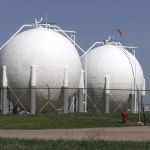West Texas Intermediate and Brent crude fell on Monday as Iraq boosted output to a record, while Saudi Arabian exports hit a 7-month high in November, underscoring OPECs firm stance to protect its market share. Expectations for a slowdown in Chinas GDP growth below the governments official target further dragged on prices.
US crude for delivery in March fell by 1.20% to $48.54 per barrel by 8:10 GMT, having shifted in a daily range of $49.20-$48.40. The contract rose 5.14% on Friday to settle the week higher for the first time in two months at $49.13 a barrel.
Meanwhile on the ICE, Brent for delivery in the same month was down 0.94% at $49.70, with prices holding in a daily range of $50.35-$49.57 a barrel. The European benchmark crude rose 3.94% on Friday to $50.17, falling for an eight straight week. Brent traded at a premium of $1.16 to its US counterpart, up from Fridays settlement at $1.04.
Oil prices have fallen by more than 50% since a June peak as the US pumped at the highest pace in more than three decades, while OPEC resisted calls to cut its own output, exacerbating concerns that slowing global economic growth will fail to soak the additional supply.
Iraq, the oil cartels second-biggest producer, is pumping at a record rate of 4 million barrels per day, Iraqi Oil Minister Adel Abdul Mahdi said. The country plans to boost crude exports to 3.3 million barrels per day in 2015, including sales from the semi-autonomous Kurdish region.
Meanwhile, Saudi Arabian supplies surged to a seven-month high of 7.3 million barrels per day from 6.9 million bpd in October, data by the Joint Organisations Data Initiative showed, while output eased to 9.61 million bpd from 9.69 million a month earlier. OPECs leading producer reduced its delivery prices to Asia in November to gain market share, while steering the 12-member group towards a defensive stance at the November 27 meeting in Vienna, when OPEC kept its 30-million bpd production quota unchanged.
The groups biggest producers have underscored their determination to keep output unchanged despite the price rout, saying that OPEC, with its consistent production pace, is not responsible for the global supply overhang and therefore shouldnt feel obliged to sacrifice its own market share to stabilize the market.
According to OPEC Secretary-General Abdalla El-Badri, an increase of around 6 million barrels per day in non-OPEC supplies has helped trigger the steep fall, which sent prices to their lowest in almost six years.
The Energy Information Administration reported on Wednesday that US crude production rose by 60 000 barrels per day to 9.192 million bpd in the seven days ended Janaury 9th, the highest level for weekly data dating back to January 1983. Crude inventories surged 5.389 million barrels to 387.8 million, while supplies at the Cushing, Oklahoma storage hub jumped to 33.9 million barrels from 32.1 million a week earlier.
Unsupportive fundamentals
“The bigger picture remains from a fundamental point-of-view,” Ric Spooner, a chief strategist at CMC Markets in Sydney, said for Bloomberg. “We have a supply surplus and there is yet to be any significant news of reduction in capacity so the market remains very vulnerable to further price decline.”
Although US producers have been idling oil rigs in the past months, the advancing production technologies have allowed for record high output to be maintained, while reducing investments and the number of operating sites.
The World Bank trimmed its global growth estimate to 3.0% this year from the previous estimate of 3.4%, citing slower expansion rates in China and Europe, while an OPEC report showed falling demand for the groups crude in 2015.
Fanning negative sentiment, Chinas National Bureau of Statistics reported that new home prices in 68 out of 70 medium and large cities fell by an annualized 4.3% in December, compared to a 3.7% drop a month earlier.
Falling under the spotlight, the statistics agency is expected to report on Tuesday that the Chinese economy expanded at the annual rate of 7.2% in the fourth quarter, falling for a second straight quarter below the governments targeted 7.5%. If confirmed, it would bring full-year growth below the target and would be the slowest in 24 years.
In Europe, the European Central Bank is broadly expected to announce full-on quantitative easing on Thursday, pointing to further weakness of the euro against the US dollar and, thus, pressure dollar-denominated commodities including oil.
Pivot points
According to Binary Tribune’s daily analysis, West Texas Intermediate February futures’ central pivot point is at $48.29. In case the contract breaches the first resistance level at $50.18, it may rise to $51.23. Should the second key resistance be broken, the US benchmark may attempt to advance $53.12.
If the contract manages to breach the first key support at $47.24, it might come to test $45.35. With this second support broken, movement to the downside could continue to $44.30.
Meanwhile, March Brent’s central pivot point is projected at $49.55. The contract will see its first resistance level at $51.03. If breached, it may rise and test $51.89. In case the second key resistance is broken, the European crude benchmark may attempt to advance $53.37.
If Brent manages to penetrate the S1 level at $48.69, it could continue down to test $47.21. With the second support broken, downside movement may extend to $46.35 per barrel.





